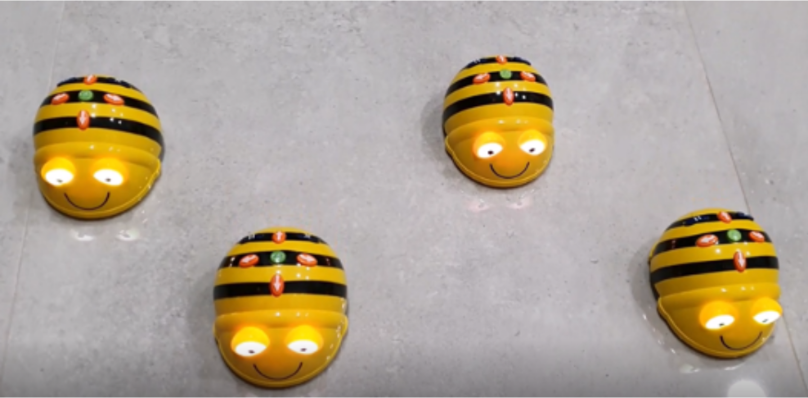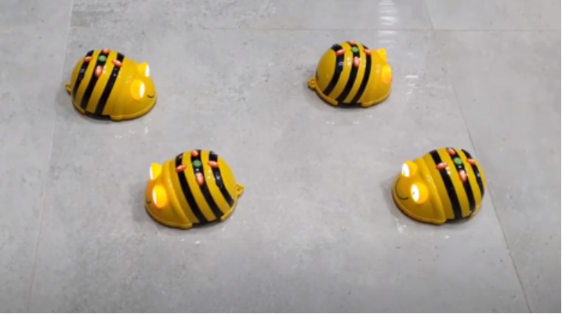Robot dancing
Body expression and educational robotics.

Abstract: This activity proposes to merge body expression and educational robotics, the main objective of the work being to develop students' body awareness and to deepen the relationship between music and movement through the movement of their own body and the movement of the robot, Bee- Bot in space.
Keywords: Bee- Bot, dancing, corporal expression, choreography, early childhood.
Resource list: Bee- Bots, music, paper, and pencils, music player or computer, loudspeakers, large and preferably ventilated space.
The background and importance of the topic
The activity is part of the "Erasmus +" STEAM-UpGrade project, Upgrading pre- and in-service teacher' digital skills with an online STEAM hands-on training module. The proposal is aimed at pre-school pupils aged between 3 and 5 years old. It is adapted for the first stages of education, considering the level of maturity of the pupil at this age.
Movement and dance are two very important agents in the development of corporal or motor expression from an early age. There are many benefits of corporal expression on a physical, intellectual, and affective level.
In addition to favoring musical learning, it allows the development of social relations through communication and interaction within the class group, creating a relaxed and non-competitive atmosphere, developing the artistic taste and creativity of the children.
Since prehistoric times, dance has been part of civilization and the daily life of humans. Dance was present in rituals, rain dances, hunts, etc., and we have evidence of this in prehistoric paintings.
![Fig. 1. Abrigo de Voro, Quesa, Valencia, Spain. Cave paintings belonging to the Levantine Rock Art, declared a World Heritage Site in 1998.
Photo: [url=https://www.quesa.es/sites/www.quesa.es/files/images/img_5675.jpg]https://www.quesa.es/sites/www.quesa.es/files/images/img_5675.jpg[/url]](https://www.geogebra.org/resource/pkza92tj/4tkn5Bx9VkYoajO8/material-pkza92tj.png)
The benefits of using dance in Infant Education are multiple and we can differentiate them in the following aspects:
- Physical level: it helps to develop coordination and body control while following a rhythm.
- Cognitive level: it boosts memory and creativity.
- Social level: promotes social cohesion, help among group members and cooperation.
- Psychological level: it involves increasing motivation and self-esteem and develops the all-important personality. Children, from being aware of their own body, develop body schemes of their own body, using it as a form of expression, being able to investigate the relationship between space and its displacement and becoming aware of the world in which they live. Today, ICT is becoming an increasingly important part of our lives. The Spanish Education Law establishes a competence-based approach to learning. Competences can be defined as the ability to apply in an integrated way the contents of each educational and teaching stage, to be able to carry out activities adequately and to solve complex problems efficiently. Digital competence implies a creative, critical, and confident use of information and communication technologies in order to achieve objectives related to work, employability, learning, use of leisure time and inclusion and participation in society.
The activity description
In the activity we will use a robot called Bee-Bot, a programmable floor robot shaped like a cute bee that is specially designed to be used in Early Childhood Education. The robot allows to teach and learn a directional language to the pupils, while initiating programming and mapping skills.
![Fig. 2 Bee-bot , Photo: [url=https://ro-botica.com/producto/bee-bot/]https://ro-botica.com/producto/bee-bot/[/url]](https://www.geogebra.org/resource/zzhehuyh/ChwVbE1ytsKoJwb0/material-zzhehuyh.png)
The Bee-Bot has seven keys:
- 90° left turn
- Go to
- Start the program (GO)
- 90° left turn
- One-second pause
- Back
- Clearing Memory
With each command the robot moves forward 15 centimeters and in the case of turning the robot will rotate 90°. It is possible to press up to 40 commands at the same time, which means that Bee-Bot can go from point A to point B according to the students' commands.
From this activity, new educational activities based on educational robotics and dance can be carried out.
The following activity is a basic proposal, simple to implement and which can be made more difficult according to the level of maturity of the pupils and the didactic objectives.
![Fig. 3 Bee-Bot
Image source: [url=https://ro-botica.com/producto/bee-bot/]https://ro-botica.com/producto/bee-bot/[/url]](https://www.geogebra.org/resource/cyxjgatt/O3rCZ53JW5NRstj8/material-cyxjgatt.png)
The Bee-Bot is made of durable material, has a built-in rechargeable battery, and is charged via a USB port.
In addition, we will need one or several pieces of music of the teacher's choice to carry out the activity, a music player or, failing that, a computer, and speakers. It is recommended to have an open space, with no protruding elements that could be dangerous and cause the children to trip.
Preparation of the Activity
The activity has two distinct parts:
A) Imitative choreography: creation and design of a choreography by the teacher: The teacher must first design the choreography which he/she will then teach to the students so that they can imitate it.
B) Programmed choreography: creation and programming of a choreography by the students: choreographies for the children to freely program their own choreography.
The teacher should prepare the first part of the activity (A) considering the specific age of the pupils. For the second part (B) it will be necessary to have 2-3 musical songs prepared.
The activity solution
Development of the Activity
· Participation. First, warm-up activities will be carried out:
- Remember the directions (front, back, left, right) as the children move in space.
- Recommended song, my body in movement, with which we will develop the students' laterality:
https://www.youtube.com/watch?v=4S7_nTdC_RU&ab_chann el=C.L.V.
- Play with the Bee-Bot and program these directions. A board can be used for ease of use.
· Description of the proposal. The motivation and interest of the children in the activity will be sought.
The teacher will carry out the following activities.
i. Play the song to be used. Students will be able to move freely around the classroom and without realising it, they will internalise the song in a fun way.
ii. The teacher will teach the commands to the students, dictating them little by little while the students program them into the robot.
iii. The music will be played and on the teacher's signal GO!, the students will tap on the green button (GO) and the Bee-Bots will start dancing.
iv. The Bee-Bots dance will be repeated but this time the children will also dance following the directions they have previously programmed.
v. Finally, the students will perform their own choreography. This activity can be done in groups or individually, depending on the number of Bee-Bots available.

The demonstration video
Enhancing the Activity
If the teacher wishes to make the activity more complex, several Bee-Bots could be used to increase the complexity of the choreography.
The material has been designed to facilitate student involvement and replicability, based on the use of different proposed songs and choreographies.
Below you will find some suggestions for enriching the proposed basic activity:
We can start with free dramatizations, singing the song as a group, moving to the rhythm and with the gestures that we think are appropriate, while the Bee-Bots also move.
The songs to be dramatized should have a plot background. It is very beneficial for the whole group to dramatize it. Another option is to divide the class into two groups in the form of a dialogue or a performance in pairs, with some singing and others acting. Another possibility is that half of the class can move with their bodies and others can activate the movement of the robots.
Through dramatization we will awaken the interest of the pupils, taking advantage of the experience and the continuity of the song that is being narrated. We will connect the song with the directions programmed by the students with the Bee-Bot.
This activity can be adapted for students with special educational needs. In the case of students with mobility difficulties, they can focus on the first part of the workshop and in the second part, the movements will be adapted so that students feel comfortable when dancing according to their abilities. At all times will be urged to be a fun and free activity for students, in no case should derive stress.
The knowledge test
Choose the right answers!
How many keys has a Bee-Bot?
How many centimeters does a Bee-boot advance with each command?
In the case of turning the robot will rotate ...
For special needs’ learners
This activity can be adapted for students with special educational needs. In the case of students with mobility difficulties, they can focus on the first part of the workshop and in the second part, the movements will be adapted so that students feel comfortable when dancing according to their abilities. At all times will be urged to be a fun and free activity for students, in no case should derive stress.
Alternative activity
If you do not have access Bee-bots robots as:
- Edison
- Ozobot Bit
- Dash and Dot
Conducting a Workshop
Different songs have been used to develop spatial and temporal concepts and healthy and hygienic habits. Body expression favors the creative and communication process, interaction and socialization, knowledge of the body and interaction with space.
For future work, it is recommended to consider the age and educational level of the pupils, the theme of the text, that it is suggestive and suitable for staging, the musical characteristics of the song (rhythm, melody, and form) and the benefit of having a musical setting that can be pre-recorded or performed live by the pupils.
Tips for the choice of songs are as follows:
It should consider the age of the target audience. The songs should preferably have the following characteristics:
- Lively and lively melodies in major keys.
- Moving songs with a strong rhythm. In case of having slower parts, it will allow us to teach the pupils to channel the energy.
- If the music has lyrics, we will look for content and vocabulary appropriate to their ages.
- Motivational songs, which may be familiar to them (films, cartoons, favorite singers, etc.).
References
Benitti, F. (2019). Exploring the educational potential of robotics in schools: A systematic review. Computers and Education, 58(3):978–988. https://doi.org/10.1016/j.compedu.2011.10.006
Kim, C., Kim, D., Yuan, J., Hill, R. B., Doshi, P., & Thai, C. N. (2015). Robotics to promote elementary education pre-service teachers' STEM engagement, learning, and teaching. Computers & Education, 91, 14-31.https://doi.org/10.1016/j.compedu.2015.08.005
Verde Trabada, A. (2021) Expresión corporal y robótica en educación infantil, in [Robótica y tecnologías emergentes aplicadas a la innovación educativa: estudios y propuestas de actividad para educación infantil y educación especial. Dykinson: Madrid.
https://www.dykinson.com/libros/robotica-y-tecnologias-emergentes-aplicadas-a-la-innovacion-educativa/9788413779928/